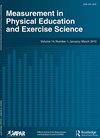The Reliability of the WAnT-Swim, a Novel Laboratory-Based, Swim-Specific Anaerobic Capacity Test Performed Using a Swimming Ergometer
IF 1.9
4区 教育学
Q2 EDUCATION & EDUCATIONAL RESEARCH
Measurement in Physical Education and Exercise Science
Pub Date : 2023-10-22
DOI:10.1080/1091367x.2023.2273304
引用次数: 0
Abstract
ABSTRACTAnaerobic capacity is an important determinant of swimming performance, and a feasible land-based test for measuring swim-specific anaerobic capacity is lacking. This study assessed the test-retest reliability of a swim-specific modification of the Wingate anaerobic capacity test: the WAnT-Swim. Ten competitive and fitness swimmers from the local college community completed four WAnT-Swim tests, two per day on two separate days, to determine peak, mean, and low power, as well as fatigue index (FI). Reliability was assessed using coefficients of variation (CV), intraclass correlation coefficients (ICC), and Pearson correlations. Power output exhibited low CV (<6%) with excellent reliability (ICC ≥0.98) and strong associations between tests (r ≥ .92). FI demonstrated the weakest reliability (CV = 3.9 ± 1.0%; ICC = 0.65; r = .13). These data suggest that the WAnT-Swim, when administered using the VASA swimming ergometer, is a reliable test of anaerobic power during land-based swimming.KEYWORDS: Anaerobic capacityswimming performanceWingate testreliability Disclosure statementNo potential conflict of interest was reported by the author(s).Additional informationFundingThis work was supported by the Syracuse University.WAnT-Swim的可靠性,这是一种新型的基于实验室的游泳特定无氧能力测试,使用游泳拉力计进行
有氧能力是游泳表现的重要决定因素,目前缺乏一种可行的陆地测试来测量游泳特有的无氧能力。本研究评估了Wingate无氧能力测试的游泳特异性修改的测试-重测可靠性:WAnT-Swim。来自当地大学社区的10名竞技和健身游泳运动员完成了四次WAnT-Swim测试,每天两次,分别在两天内完成,以确定峰值、平均和低功率以及疲劳指数(FI)。采用变异系数(CV)、类内相关系数(ICC)和Pearson相关性评估信度。输出功率CV值低(<6%),可靠性好(ICC≥0.98),试验间相关性强(r≥0.92)。FI的信度最弱(CV = 3.9±1.0%;ICC = 0.65;R = .13)。这些数据表明,当使用VASA游泳测功仪时,WAnT-Swim是陆地游泳期间无氧能力的可靠测试。关键词:无氧容量游泳性能温盖特测试可靠性披露声明作者未报告潜在利益冲突。本研究得到了锡拉丘兹大学的支持。
本文章由计算机程序翻译,如有差异,请以英文原文为准。
求助全文
约1分钟内获得全文
求助全文
来源期刊

Measurement in Physical Education and Exercise Science
Medicine-Orthopedics and Sports Medicine
CiteScore
4.20
自引率
33.30%
发文量
24
期刊介绍:
The scope of Measurement in Physical Education and Exercise Science (MPEES) covers original measurement research, special issues, and tutorials within six substantive disciplines of physical education and exercise science. Six of the seven sections of MPEES define the substantive disciplines within the purview of the original research to be published in the journal: Exercise Science, Physical Activity, Physical Education Pedagogy, Psychology, Research Methodology and Statistics, and Sport Management and Administration. The seventh section of MPEES, Tutorial and Teacher’s Toolbox, serves to provide an outlet for review and/or didactic manuscripts to be published in the journal. Special issues provide an avenue for a coherent set of manuscripts (e.g., four to five) to collectively focus in-depth on an important and timely measurement-related issue within the scope of MPEES. The primary aim of MPEES is to publish high-impact manuscripts, most of which will focus on original research, that fit within the scope of the journal.
 求助内容:
求助内容: 应助结果提醒方式:
应助结果提醒方式:


